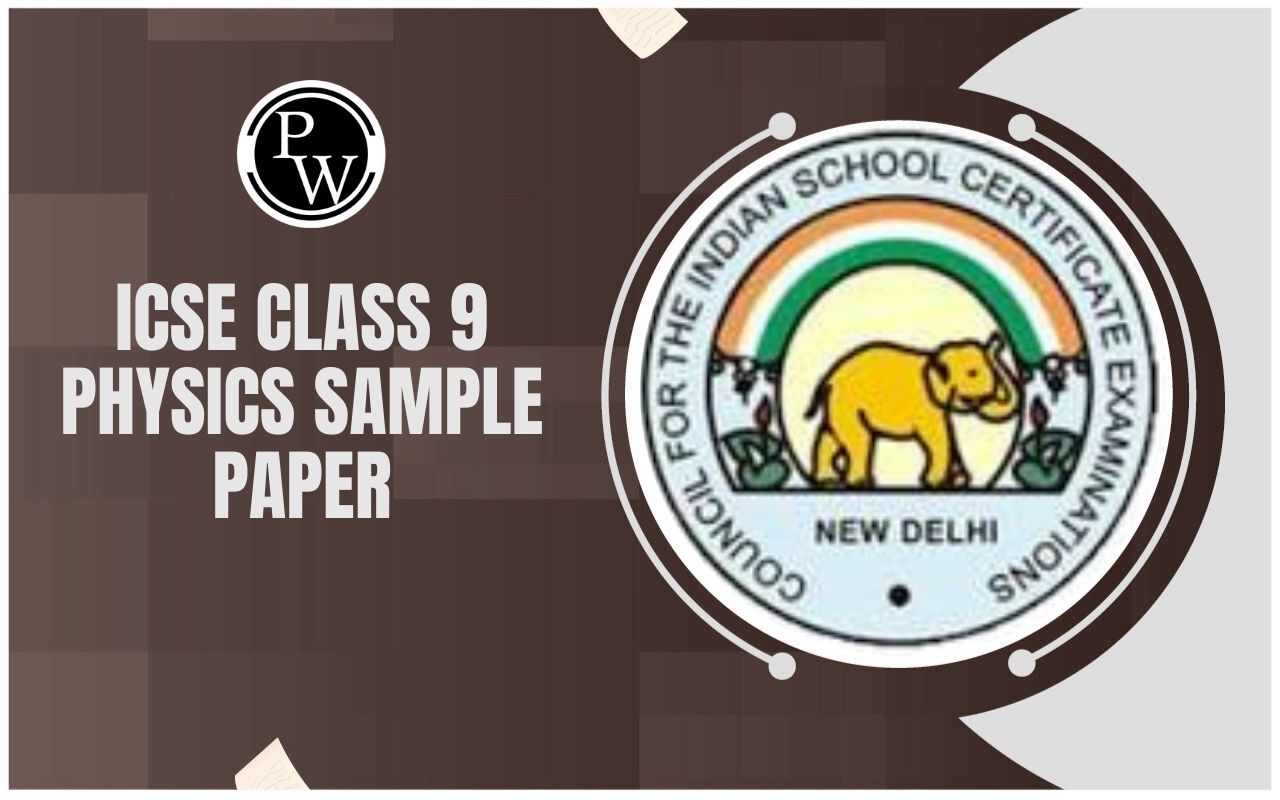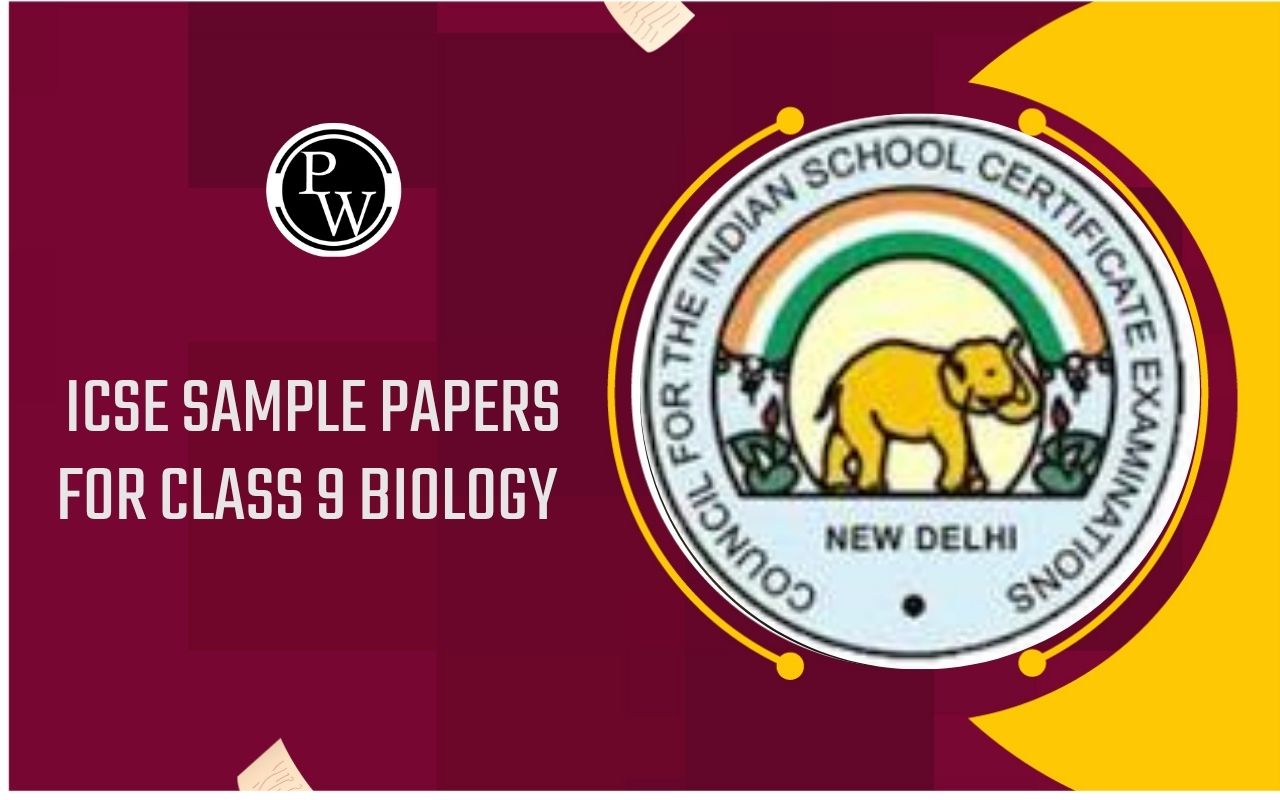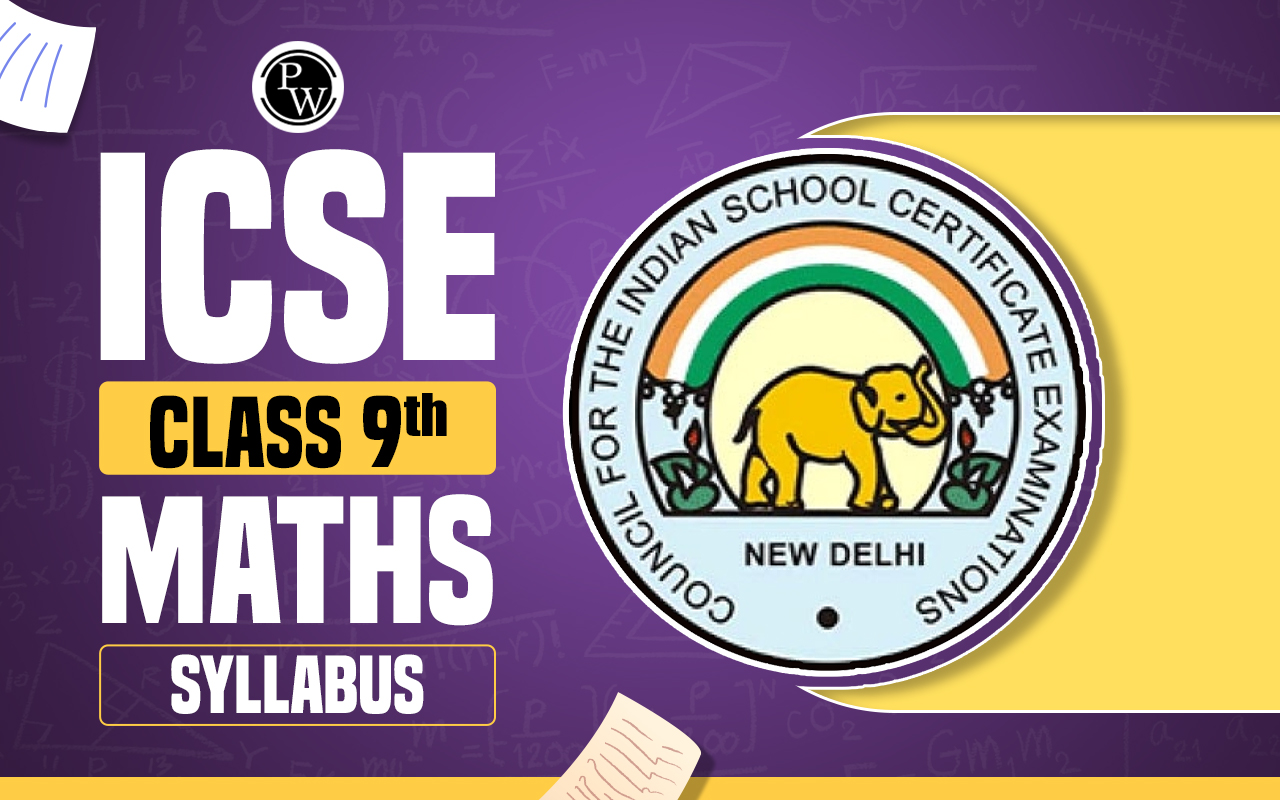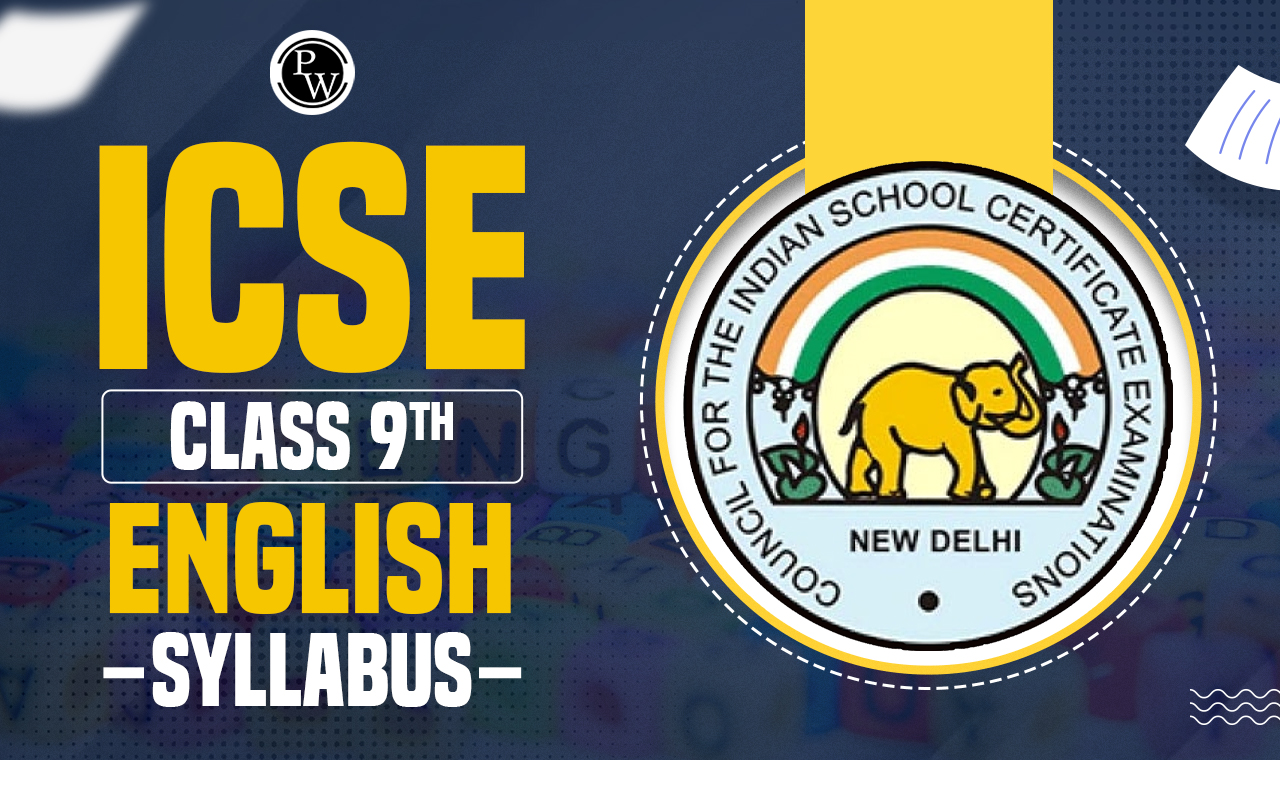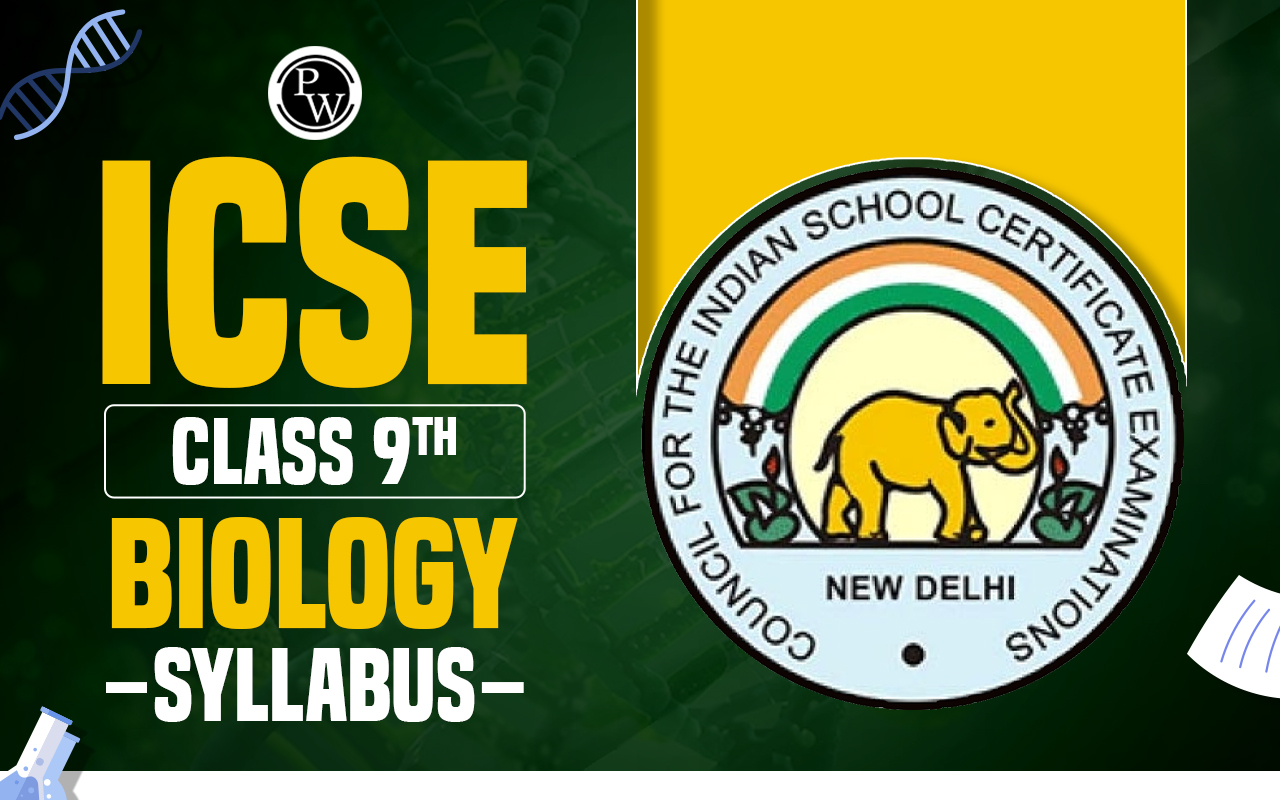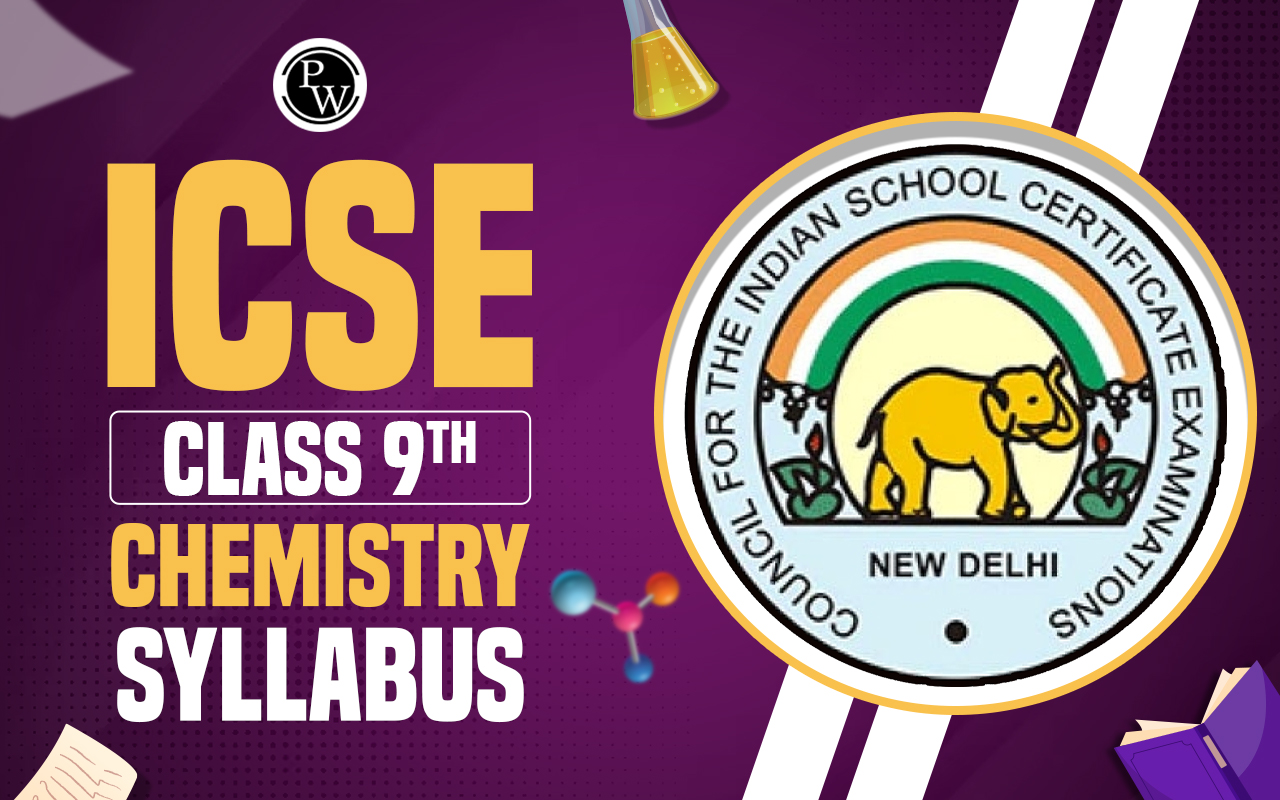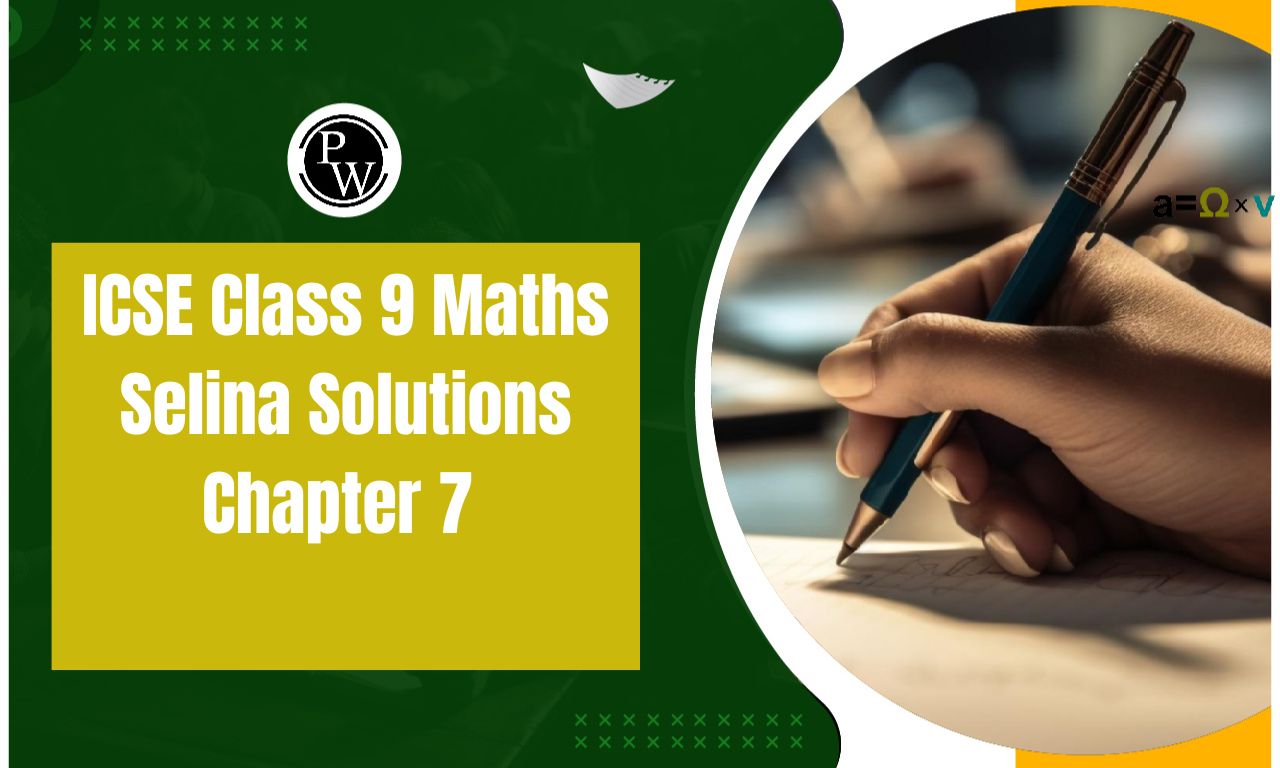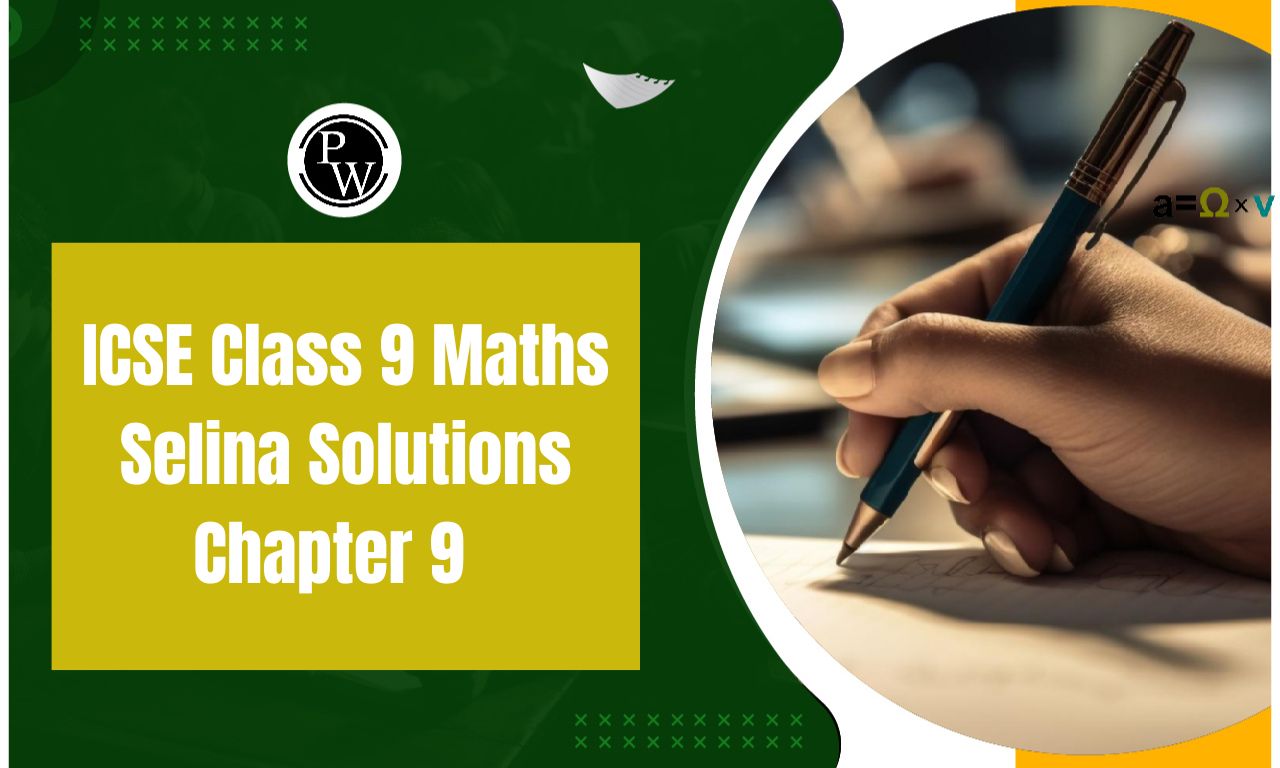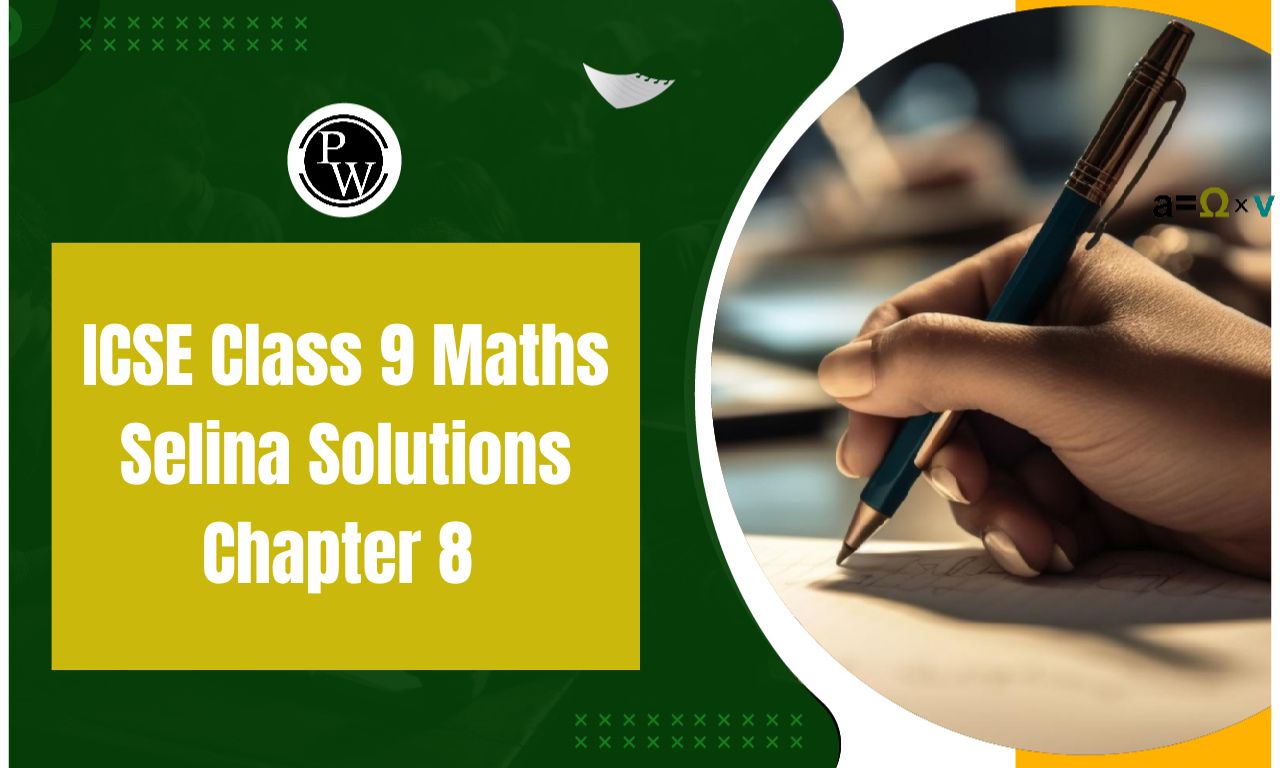
ICSE Class 9 Maths Selina Solutions Chapter 2: ICSE Class 9 Maths Selina Solutions Chapter 2 on Compound Interest provide detailed guidance on understanding and calculating compound interest. The solutions provided guide students step-by-step, showing how interest builds on both the original amount and any previously earned interest.
By focusing on clear explanations, this chapter helps students improve their problem-solving abilities and prepares them well for exams.ICSE Class 9 Maths Selina Solutions Chapter 2 Compound Interest (Without Using Formula) Overview
Physics Wallah ICSE Class 9 Maths Selina Solutions Chapter 2 on Compound Interest (Without Using Formula) is prepared by subject experts to provide a clear understanding. It helps students see how interest grows over time on both the initial amount and the previously earned interest. The solutions are straightforward, aiming to improve students understanding and ability to solve problems. Physics Wallah focuses on equipping students with the skills needed to handle compound interest questions confidently in exams and in practical situations.ICSE Class 9 Maths Selina Solutions Chapter 2 PDF
You can access the PDF link for ICSE Class 9 Maths Selina Solutions Chapter 2 below. This PDF provides detailed solutions to problems related to compound interest, presented in a clear and structured format. It aims to help students understand the concepts effectively by offering step-by-step explanations and practical examples.ICSE Class 9 Maths Selina Solutions Chapter 2 PDF
ICSE Class 9 Maths Selina Solutions Chapter 2 Compound Interest (Without Using Formula)
Here we have provided ICSE Class 9 Maths Selina Solutions Chapter 2 Compound Interest (Without Using Formula) for the ease of students so that they can prepare better for their exams.ICSE Class 9 Maths Selina Solutions Chapter 2 Exercise 2(A)
1. ₹16,000 is invested at 5% compound interest compounded per annum.
Use the table, given below, to find the amount in 4 years.
| Year | Initial amount (₹) | Interest (₹) | Final amount |
| 1 st | 16,000 | 800 | 16,800 |
| 2 nd | |||
| 3 rd | |||
| 4 th | |||
| 5 th |
Solution:
| Year | Initial amount (₹) | Interest (₹) | Final amount |
| 1 st | 16,000 | 800 | 16,800 |
| 2 nd | 16,800 | 840 | 17,640 |
| 3 rd | 17,640 | 882 | 18,522 |
| 4 th | 18,522 | 926.10 | 19,448.10 |
| 5 th | 19,448.10 | 972.405 | 20,420.505 |
2.(i) Calculate the amount and the compound interest on:
₹ 6000 in 3 years at 5% per year.(ii) Calculate amount and the compound interest on:
₹ 8000 in 2½ years at 15% per annum.Solution:
(i) Given: P = ₹6,000; N = 3 years and R = 5% For the 1 st year P = ₹6000; N = 1 year and R = 5% Interest = (6000 x 5 x 1)/100 = ₹300 And, amount = ₹(6000 + 300) = ₹6,300 For the 2 nd year P = ₹6300; N = 1 year and R = 5% Interest = (6300 x 5 x 1)/100 = ₹315 And, amount = ₹(6300 + 315) = ₹6,615 For the 3 rd year P = ₹6,615; N = 1 year and R = 5% Interest = (6615 x 5 x 1)/100 = ₹330.75 And, amount = ₹(6,615 + 330.75) = ₹6,945.75 Hence, the C.I. accrued = Final amount – Initial principal = ₹6,945.75 – ₹6,000 = ₹945.75 (ii) Given: P = 8000; N = 2½ years and R = 15% For the 1 st year P = ₹8,000; N = 1 year and R = 15% Interest = (8000 x 15 x 1)/100 = ₹1,200 And, amount = ₹(8,000 + 1,200) = ₹9,200 For the 2 nd year P = ₹9,200; N = 1 year and R = 15% Interest = (9200 x 15 x 1)/100 = ₹1,380 And, amount = ₹(9,200 + 1,380) = ₹10,580 For the next ½ year P = ₹10,580; N = ½ year and R = 15% Interest = (10580 x 15 x ½)/100 = ₹793.50 And, amount = ₹(10,580 + 793.50) = ₹11,373.50 Hence, the C.I. accrued = Final amount – Initial principal = ₹11,373.50 – ₹8,000 = ₹3,373.503. Calculate the amount and the compound interest on:
(i) ₹ 4,600 in 2 years when the rates of interest of successive years are 10% and 12% respectively.
(ii) ₹ 6,000 in 3 years, when the rates of the interest for successive years are 10%, 14% and 15% respectively.
Solution:
(i) For 1 st year P = ₹4,600; R = 10% and T = 1 year I = (4600 x 10 x 1)/100 = ₹460 And, A = ₹(4,600 + 460) = ₹5,060 For 2 nd year P = ₹5,060; R = 12% and T = 1 year. I = (5060 x 12 x1)/100 = 60720/100 = ₹607.20 And, A = ₹(5,060 + 607.20) = ₹5,667.20 Compound interest = ₹(5,667.20 – 4,600) = ₹1,067.20 Amount after 2 years = ₹5,667.20 (ii) For 1 st year P = ₹16,000; R = 10% and T = 1 year I = (16000 x 10 x 1)/100 = ₹1,600 And, A = ₹(16,000 + 1,600) = ₹17,600 For 2 nd year P = ₹17,600; R = 14% and T = 1 year I = (17600 x 14 x 1)/100 = 246400/100 = ₹2,464 And, A = ₹(17,600 + 2,464) = ₹20,064 For 3 rd year, P = ₹20,064; R = 15% and T = 1 year I = (20064 x 15 x 1)/100 = ₹3,009.60 And, Amount after 3 years = ₹(20,064 + 3,009.60) = ₹23,073.60 Hence, Compound interest = ₹(23,073.60 – 16,000) = ₹7,073.604. Find the compound interest, correct to the nearest rupee, on ₹ 2,400 for 2½ years at 5 per cent per annum.
Solution:
For 1 st year P = ₹2400; R = 5% and T = 1 year I = (2400 x 5 x 1)/100 = ₹120 A = ₹(2400 + 120) = ₹2520 For 2 nd year P = ₹2520; R = 5% and T = 1 year I = (2520 x 5 x 1)/100 = ₹126 A = ₹(2,520 + 126) = ₹2,646 For the final ½ year P = Rs. 2646; R = 5% and T = ½ year I = (2646 x 5 x 1)/(100 x 2) = ₹66.15 Amount after 2½ years = ₹2,646 + ₹66.15 = ₹2,712.15 Hence, Compound interest = ₹(2,712.15 – 2,400) = ₹312.155. Calculate the compound interest for the second year on ₹ 8,000 invested for 3 years at 10% per annum.
Solution:
For 1 st year P = ₹8,000; R = 10% and T = 1 year I = (8000 x 10 x 1)/100 = 800 And, A = ₹(8,000 + 800) = ₹8,800 For 2 nd year P = ₹8,800; R = 10% and T = 1 year I = (8800 x 10 x 1)/100 = ₹880 Hence, Compound interest for 2 nd years = ₹8806. A borrowed ₹ 2,500 from B at 12% per annum compound interest. After 2 years, A gave ₹ 2,936 and a watch to B to clear the account. Find the cost of the watch.
Solution:
For 1 st year P = ₹2500; R = 12% and T = 1 year I = (2500 x 12 x 1)/100 = ₹300 And, Amount = ₹(2,500 + 300) = ₹2,800 For 2 nd year P = ₹2,800; R = 12% and T = 1 year I = (2800 x 12 x 1)/100 = ₹336 And, Amount = ₹(2,800 + 336) = ₹3136 Now, Amount repaid by A to B = ₹2936 The amount of watch = ₹(3136 – 2936) = ₹2007. How much will ₹ 50,000 amount to in 3 years, compounded yearly, if the rates for the successive years are 6%, 8% and 10% respectively?
Solution:
Given: P = ₹50,000; T = 3 years Interest for the 1 st year, R = 6% I = (P x R x T)/100 = (50000 x 6 x 1)/100 = ₹3,000 And, Amount after the 1 st year = ₹(3,000 + 50,000) = ₹53,000 Now, Interest for the 2 nd year, R = 8% and P = ₹53,000 I = (P x R x T)/100 = (53000 x 8 x 1)/100 = ₹4,240 And, Amount after the 2 nd year = ₹(4,240 + 53,000) = ₹57,240 Next, Interest for the 3 rd year, R = 10% and P = ₹57,240 I = (P x R x T)/100 = (57240 x 10 x 1)/100 = ₹5,724 And, Amount after the 3 rd year = ₹(5,724 + 57,240) = ₹62,964 Hence, the amount after 3 years will be ₹62,9648. Meenal lends ₹ 75,000 at C.I. for 3 years. If the rate of interest for the first two years is 15% per year and for the third year it is 16%, calculate the sum Meenal will get at the end of the third year.
Solution:
Given: P = ₹75,000; T = 3 years Interest for the 1 st year, R = 15% I = (P x R x T)/100 = (75000 x 15 x 1)/100 = ₹11,250 And, Amount after the 1 st year = ₹(75,000 + 11,250) = ₹86,250 Now, Interest for the 2 nd year, R = 15% and P = ₹86,250 I = (P x R x T)/100 = (86250 x 15 x 1)/100 = ₹12,937.50 And, Amount after the 2 nd year = ₹(12,937.50 + 86,250) = ₹99,187.50 Next, Interest for the 3 rd year, R = 16% and P = ₹99,187.50 I = (P x R x T)/100 = (99187.50 x 16 x 1)/100 = ₹15,870 And, Amount after the 3 rd year = ₹(15,870 + 99,187.50) = ₹1,15,057.5 Hence, at the end of 3 years Meenal will get an amount of ₹1,15,057.59. Govind borrows ₹ 18,000 at 10% simple interest. He immediately invests the money borrowed at 10% compound interest compounded half-yearly. How much money does Govind gain in one year?
Solution:
Calculating the simple interest P = ₹18,000; R = 10% and T = 1year, we have S.I.= (18000 x 10 x 1)/100 = ₹1,800 Calculating the compound interest (compounded half-yearly) For 1 st half- year P = ₹18,000; R = 10% and T = ½ year Interest = (18000 x 10 x 1)/(100 x 2) = ₹900 So, Amount = ₹18,000 + ₹900 = ₹18,900 Now, For 2 nd half-year P = ₹18,900; R = 10% and T = ½ year Interest = (18,900 x 10 x 1)/(100 x 2) = ₹945 Rs So, Amount = ₹18,900 + ₹945 = ₹19,845 Then, Compound interest = ₹(19,845 -18,000) = ₹1,845 Therefore, Govind’s gain = ₹(1,845 – 1,800) = ₹4510. Find the compound interest on ₹4,000 accrued in three years, when the rate of interest is 8% for the first year and 10% per year for the second and the third years.
Solution:
Given: P = ₹4,000; T = 3 years Interest for the 1 st year, R = 8% I = (P x R x T)/100 = (4000 x 8 x 1)/100 = ₹320 And, Amount after the 1 st year = ₹(4,000 +320) = ₹4,320 Now, Interest for the 2 nd year, R = 10% and P = ₹4,320 I = (P x R x T)/100 = (4320 x 10 x 1)/100 = ₹432 And, Amount after the 2 nd year = ₹(432 + 4,320) = ₹4,752 Next, Interest for the 3 rd year, R = 10% and P = ₹4,752 I = (P x R x T)/100 = (4,752 x 10 x 1)/100 = ₹475.20 And, Amount after the 3 rd year = ₹(475.20 + 4,752) = ₹5,227.20 Hence, The compound interest = ₹(5227.20 – 4,000) = ₹1,227.20ICSE Class 9 Maths Selina Solutions Chapter 2 Compound Interest (Without Using Formula) Exercise 2(B)
1. Calculate the difference between the simple interest and the compound interest on ₹ 4,000 in 2 years at 8% per annum compounded yearly.
Solution:
For 1 st year P = ₹4,000; R = 8% and T = 1 year I = (4,000 x 8 x 1)/100 = ₹320 And, A = ₹(4,000 + 320) = ₹4,320 For 2 nd year P = ₹4,320; R = 8% and T = 1 year I = (4,320 x 8 x 1)/100 = ₹345.60 And, A = ₹(4,320 + 345.60) = ₹4,665.60 Hence, Compound interest = ₹(4,665.60 – 4,000) = ₹665.60 Now, Simple interest for 2 years = (4000 x 8 x 2)/100 = ₹640 Hence, Difference of CI and SI = ₹(665.60 – 640) = ₹25.602. A man lends ₹ 12,500 at 12% for the first year, at 15% for the second year and at 18% for the third year. If the rates of interest are compounded yearly ; find the difference between the C.I. for the first year and the compound interest for the third year.
Solution:
For 1 st year P = Rs. 12500; R = 12% and R = 1 year I = (12500 x 12 x 1)/100 = ₹1,500 And, A = ₹(12,500 + 1,500) = ₹14,000 For 2 nd year P = ₹14,000; R = 15% and T = 1 year I = (14000 x 15 x 1)/100 = ₹2,100 And, A = ₹(1,400 + 2,100) = ₹16,100 For 3 rd year P = ₹16,100; R = 18% and T = 1 year I = (16100 x 18 x 1)/100 = ₹2898 And, A = ₹(16,100 + 2,898) = ₹18,998 Hence, The difference between the compound interest of the third year and first year = ₹2,898 – ₹1,500 = ₹1,3983. A sum of money is lent at 8% per annum compound interest. If the interest for the second year exceeds that for the first year by ₹ 96, find the sum of money.
Solution:
Let’s assume the money lent to be ₹100 So, For 1 st year P = ₹100; R = 8% and T = 1 year Interest for the first year = (100 x 8 x 1)/100 = ₹8 Amount = ₹(100+ 8) = ₹108 For 2 nd year P = ₹108; R = 8% and T = 1year Interest for the second year = (108 x 8 x 1)/100 = ₹8.64 Now, Difference between the interests for the second and first year = ₹(8.64 – 8) = ₹0.64 But given that interest for the second year exceeds the first year by ₹96 Then, When the difference between the interests is ₹0.64, principal is ₹100 So, When the difference between the interests is ₹96, principal = ₹(96 x 100/0.64) = ₹15,000 Therefore, the sum of money lent is ₹15,0004. A man borrows ₹ 6,000 at 5% C.I. per annum. If he repays ₹ 1,200 at the end of each year, find the amount of the loan outstanding at the beginning of the third year.
Solution:
Given, amount borrowed = ₹6,000 at R = 5% C.I. per annum So, Interest for the 1 st year = (5/100 x 6000) = ₹300 And, the amount at the end of the first year will be = ₹(6,000 + 300) = ₹6,300 Given that an amount of ₹1,200 is repaid at the end of each year Now, The amount left to the paid at the end of 1 st year = ₹(6,300 – 1,200) = ₹5,100 Then, the interest for the 2 nd year is = (5/100 x 5100) = ₹255 And, the amount will be = ₹(5100 + 255) = ₹5,355 Now, the amount left to be paid at the end of 2 nd year after reduction of ₹1,200 will be = ₹(5,355 – 1,200) = ₹4,155 Hence, the amount of the loan outstanding at the beginning of the third year is ₹4,1555. A man borrows ₹ 5,000 at 12 percent compound interest payable every six months. He repays ₹ 1,800 at the end of every six months. Calculate the third payment he has to make at the end of 18 months in order to clear the entire loan.
Solution:
For 1 st six months: P = ₹5,000; R = 12% and T = ½ year Interest = (5000 x 12 x 1)/(2 x 100) = ₹300 And, Amount = ₹(5,000 + 300) = ₹5,300 Given that the money repaid = ₹1,800 So, balance amount = ₹(5,300 – 1,800) = ₹3,500 For 2 nd six months: P = ₹3,500; R = 12% and T = ½ year Interest = (3500 x 12 x 1)/(2 x 100) = ₹210 And, Amount = ₹(3,500 + 210) = ₹3,710 Again the money repaid = ₹1,800 So, balance amount = ₹(3,710 – 1,800) = ₹1,910For 3 rd six months: P = ₹1,910; R = 12% and T = ½ year Interest = (1910 x 12 x 1)/(2 x 100) = ₹114.60 And, Amount = ₹(1,910 + 114.60) = ₹2,024.60 Hence, the 3 rd payment to be made to clear the entire loan is ₹2,024.60
6. On a certain sum of money, the difference between the compound interest for a year, payable half-yearly, and the simple interest for a year is ₹ 180. Find the sum lent out, if the rate of interest in both the cases is 10% per annum.
Solution:
Let assume a principal of ₹100 And, for R = 10% and T = 1 year S.I. = (100 x 10 x 1)/100 = ₹10 Compound interest payable half yearly R = 5% half-yearly, T = ½ year = 1 half-year Now, for first ½ year I = (100 x 5 x 1)/100 = ₹5 And, A = ₹(100 + 5) = ₹105 For second ½ year P = ₹105 and R = 5% I = (105 x 5 x 1)/100 = ₹5.25 Total compound interest = ₹(5 + 5.25) = ₹10.25 Difference of C.I. and S.I. = ₹(10.25 – 10) = ₹0.25 So, when difference in interest is ₹10.25, the sum is ₹100 So, if the difference is ₹1, the sum is (100/0.25) = 400 And, If the difference is ₹180, the sum will be ₹(400 x 180) = ₹72,000 Hence, the sum lent out is ₹72,0007. A manufacturer estimates that his machine depreciates by 15% of its value at the beginning of the year. Find the original value (cost) of the machine, if it depreciates by ₹ 5,355 during the second year.
Solution:
Let’s assume the original cost of the machine to be ₹100 Given that the machine depreciates by 15% during the first year So, 15% of ₹100 = ₹15 Now, The value of the machine at the beginning of the 2 nd year will be = ₹(100 – 15) = ₹85 Again, the depreciation during the 2 nd year = 15% of ₹85 = ₹12.75 Now, When the depreciation during the 2 nd year is ₹12.75, the original cost is ₹100 So, When the depreciation during the 2 nd year is ₹5,355, the original cost will be = (100 x 5355)/12.75 = ₹42,000 Therefore, the original cost of the machine is ₹42,0008. A man invest ₹ 5,600 at 14% per annum compound interest for 2 years. Calculate:
(i) The interest for the first year.
(ii) The amount at the end of the first year.
(iii) The interest for the second year, correct to the nearest rupee.
Solution:
(i) For the 1 st year P = ₹5,600; R = 14% and T = 1 year I = (5600 x 14 x 1)/100 = ₹784 And, (ii) Amount at the end of the first year is = ₹(5600 + 784) = ₹6,384 (iii) Now, for the 2 nd year P = ₹6,384; R = 14% and R = 1 year I = (6384 x 14 x 1)/100 = ₹893.76 ~ ₹894 (nearly) Hence, the interest for the second year is ₹8949. A man saves ₹ 3,000 every year and invests it at the end of the year at 10% compound interest. Calculate the total amount of his savings at the end of the third year.
Solution:
Savings at the end of every year = ₹3,000 So, for 2 nd year P = ₹3,000; R = 10% and T = 1 year I = (3000 x 10 x 1)/100 = ₹300 And, A = ₹(3000 + 300) = ₹3,300 Now, For 3 rd year, savings = ₹3,000 So, P = ₹(3,000 + 3,300) = ₹6,300 R = 10% and T = 1 year I = (6300 x 10 x 1)/100 = ₹630 And, A = ₹(6,300 + 630) = ₹6,930 Amount at the end of 3 rd year = ₹(6,930 + 3,000) = ₹9,930 Hence, the total amount of his savings at the end of the third year is ₹9,93010. A man borrows ₹ 10,000 at 5% per annum compound interest. He repays 35% of the sum borrowed at the end of the first year and 42% of the sum borrowed at the end of the second year. How much must he pay at the end of the third year in order to clear the debt?
Solution:
Given, The amount borrowed is ₹10,000 at R = 5% Interest for the 1 st year I = (10000 x 5)/100 = ₹500 And, the amount at the end of 1 st year = ₹(10,000 + 500) = ₹10,500 It’s said that the man pays 35% of ₹10,500 at the end of the first year = (35 x 10500)/100 = ₹3,675 So, the amount left to be paid will be = ₹(10,500 – 3,675) = ₹6,825 Now, The interest for the 2 nd year is I = (6,825 x 5)/100 = ₹341.5 So, the amount at the end of the 2 nd year will be = ₹(6,825 + 341.25) = ₹7,166.25 Given that the man pays 42% of ₹7,166.25 at the end of 2 nd year = (42 x 7166.25)/100 = ₹3,009.825 So, the amount left to be paid = ₹(7,166.25 – 3,009.825) = ₹4,156.425 Now, the interest for the third year = (4156.425 x 5)/100 = ₹207.82125 So, the amount at the end of the third year will be = (4,156.425 + 207.82125) = ₹4,364.24625 Hence, the man must pay an amount of ₹4,364.24625 at the end of 3 rd year in order to clear the debt.ICSE Class 9 Maths Selina Solutions Chapter 2 Compound Interest (Without Using Formula) Exercise 2(C)
1. A sum is invested at compound interest, compounded yearly. If the interest for two successive years is ₹ 5,700 and ₹ 7,410, calculate the rate of interest.
Solution:
We know that. Rate of interest (%) = (Difference in the interest of the two consecutive periods x 100)/(C.I. of preceding year x time) = [(7410 – 5700) x 100]/(5700 x 1) = 30% Hence, the rate of interest is 30%2. A certain sum of money is put at compound interest, compounded half-yearly. If the interest for two successive half-years are ₹ 650 and ₹ 760.50; find the rate of interest.
Solution:
The difference between the C.I. of two successive half-years is = ₹(760.50 – 650) = ₹110.50 So, ₹110.50 is the interest of one half-year on ₹650 Thus, Rate of interest = (100 x I)/(P x T) % = (100 x 110.50)/(650 x ½) = 34%3. A certain sum amounts to ₹ 5,292 in two years and ₹ 5,556.60 in three years, interest being compounded annually. Find:
(i) the rate of interest.
(ii) the original sum.
Solution:
(i) Given, Amount in two years = ₹5,292 Amount in three years = ₹5,556.60 So, the difference between the amounts of two successive years is = ₹5,556.60 – ₹5,292 = ₹264.60 Hence, ₹264.60 is the interest for one year on ₹5,292 Thus, Rate of interest = (100 x I)/(P x T) = (100 x 264.60)/(5292 x 1) = 5% (ii) Let’s assume the sum of money to be ₹100 Then, the interest on it for the 1 st year will be = 5% of ₹100 = ₹5 So, the amount in one year = ₹(100 + 5) = ₹105 Similarly, The amount in two years = ₹105 + 5% of ₹105 = ₹(105+ 5.25) = ₹110.25 When amount in two years is ₹110.25, sum = ₹100 Hence, When amount in two years is ₹5,292, sum = ₹(100 x 5292)/110.25 = ₹4,8004. The compound interest, calculated yearly, on a certain sum of money for the second year is ₹ 1,089 and for the third year it is ₹ 1,197.90. Calculate the rate of interest and the sum of money.
Solution:
(i) C.I. for second year = ₹1,089 C.I. for third year = ₹1,197.90 Thus, the difference between the C.I. of two successive years = ₹(1,197.90 – 1,089) = ₹108.90 Hence, ₹108.90 is the interest of one year on ₹1,089 Thus, Rate of interest = (100 x I)/(P x T) = (100 x 108.90)/(1089 x 1) = 10% (ii) Let’s assume the sum of money to be ₹100 So, interest on it for in the 1 st year = 10% of ₹100 = ₹10 And, the amount after one year = ₹(100 + 10) = ₹110 Similarly, C.I. for the 2 nd year = 10% of ₹110 = ₹11 When C.I. for 2 nd year is ₹11, the sum is ₹100 Hence, When C.I. for 2 nd year is ₹1,089, the sum is ₹(100 x 1089)/11 = ₹9,9005. Mohit invests ₹ 8,000 for 3 years at a certain rate of interest, compounded annually. At the end of one year it amounts to ₹ 9,440. Calculate:
(i) the rate of interest per annum.
(ii) the amount at the end of the second year.
(iii) the interest accrued in the third year.
Solution:
For the 1 st year P = ₹8,000; A = ₹9,440 and T = 1 year Interest = ₹(9,440 – 8,000) = ₹1,440 So, Rate = (I x 100)/(P x T) = (1,440 x 100)/(8,000 x 1 = 18% (i) Hence, the rate of interest per annum is 18% For the 2 nd year P = ₹9,440; R = 18% and T = 1year Interest = (9440 x 18 x 1)/100 = ₹1,699.20 And, Amount = ₹ (9,440 + 1,699.20) = ₹11,139.20 (ii) Hence, the amount at the end of second year is ₹11,139.20 For the 3 rd year P = ₹11,139.20; R = 18% and T = 1year Interest = (11139.20 x 18 x 1)/100 = ₹2,005.06 (iii) Hence, the interest accrued in the third year is ₹2,005.066. Geeta borrowed ₹ 15,000 for 18 months at a certain rate of interest compounded semi-annually. If at the end of six months it amounted to ₹ 15,600; Calculate :
(i) the rate of interest per annum.
(ii) the total amount of money that Geeta must pay at the end of 18 months in order to clear the account.
Solution:
For 1 st half-year P = ₹15,000; A = ₹15,600 and T = ½ year Now, Interest = ₹(15,600 – 15,000) = ₹600 (i) Hence, Rate = (I x 100)/(P x T)% = 8% For 2 nd half-year P = ₹15,600; R = 8% and T = ½ year Interest = (15,000 x 8 x ½)/100 = ₹624 So, Amount = ₹(15,600 + 624) = ₹16,224 For 3 rd half-year P = ₹16,224; R = 8% and T = ½ year Interest = (16,224 x 8 x ½)/100 = ₹648.96 So, Amount = ₹(16,224 + 648.96) = ₹16,872.96 Therefore, the total amount of money that Geeta must pay at the end of 18 months in order to clear the account is ₹16,872.967. Ramesh invests ₹ 12,800 for three years at the rate of 10% per annum compound interest. Find:
(i) the sum due to Ramesh at the end of the first year.
(ii) the interest he earns for the second year.
(iii) the total amount due to him at the end of the third year.
Solution:
For 1 st year P = ₹12,800; R = 10% and T = 1year Interest = (12,800 x 10 x 1)/100 = ₹1,280 And, Amount = ₹(12,800 +1,280) = ₹14,080 (i) Hence, at the sum due to Ramesh at the end of the first year is ₹14,080 For 2 nd year P = ₹14,080; R = 10% and T = 1 year Interest = (14,080 x 10 x 1)/100 = ₹1,408 (ii) Hence, the interest the interest earned for the second year is ₹1,408 And, Amount = ₹(14,080 + 1,408) = ₹15,488 For 3 rd year P = ₹15,488; R = 10% and T = 1 year Interest = ₹(15,488 x 10 x 1)/100 = ₹1,548.80 And, Amount = ₹(15,488 + 1,548.80) = ₹17,036.80 (iii) Hence, the total amount due to Ramesh at the end of third year is ₹17,036.808. ₹ 8,000 is lent out at 7% compound interest for 2 years. At the end of the first year ₹ 3,560 are returned. Calculate:
(i) the interest paid for the second year.
(ii) the total interest paid in two years.
(iii) the total amount of money paid in two years to clear the debt.
Solution:
(i) For 1 st year P = ₹8,000; R = 7% and T = 1 year Interest = (8,000 x 7 x 1)/100 = ₹560 Amount = ₹(8,000 + 560) = ₹8,560 Now, the money returned = ₹3,560 So, Balance money for 2 nd year = ₹(8,560 – 3,560) = ₹5,000 For 2 nd year P = ₹5,000; R = 7% and T = 1 year Interest paid for the second year = (5000 x 7 x 1)/100 = ₹350 (ii) The total interest paid in two years = ₹(350 + 560) = ₹910 (iii) The total amount of money paid in two years to clear the debt = ₹(8,000 + 910) = ₹8,9109. The cost of a machine depreciated by ₹ 4,000 during the first year and by ₹ 3,600 during the second year. Calculate:
(i) The rate of depreciation
(ii) The original cost of the machine
(iii) It’s cost at the end of the third year
Solution:
(i) Difference between depreciation in value between the first and second years is ₹(4,000 – 3,600) = ₹400 So, the depreciation of one year on ₹4,000 = ₹400 Hence, the rate of depreciation = (40/4000) x 100% = 10% (ii) Let’s assume ₹100 to be the original cost of the machine Depreciation during the 1 st year = 10% of ₹100 = ₹10 So, When the values depreciates by Rs.10 during the 1 st year, then the original cost is ₹10 Then, when the depreciation during 1 st year is ₹4,000, the original cost is (100/10) x 4,000 = ₹40,000 Hence, the original cost of the machine is ₹40,000. (iii) Total depreciation during all the three years = Depreciation in value during (1 st year + 2 nd year + 3 rd year) = ₹4,000 + ₹3,600 + 10% of (₹40,000 – ₹7,600) = ₹4,000 + ₹3,600 + ₹3,240 = ₹10,840 Thus, The cost of the machine at the end of the third year = ₹40,000 – ₹10,840 = ₹29,16010. Find the sum, invested at 10% compounded annually, on which the interest for the third year exceeds the interest of the first year by ₹ 252.
Solution:
Let’s assume the sum of money be ₹100 And, the rate of interest = 10% p.a. Interest at the end of 1 st year = 10% of ₹100 = ₹10 Amount at the end of 1 st year = ₹(100 + 10) = ₹110 Interest at the end of 2 nd year = 10% of ₹110 = ₹11 Amount at the end of 2 nd year = ₹(110 + 11) = ₹121 Interest at the end of 3 rd year = 10% of ₹121 = ₹12.10 Hence, the difference between interest of 3 rd year and 1 st year = ₹(12.10 – 10) = ₹2.10 Now, When difference is ₹2.10, the principal is ₹100 When difference is ₹252, the principal = (100 x 252)/(2 x 10) = ₹12,000 Hence, the sum invested is ₹12,00011. A man borrows ₹ 10,000 at 10% compound interest compounded yearly. At the end of each year, he pays back 30% of the sum borrowed. How much money is left unpaid just after the second year?
Solution:
For 1 st year P = ₹10,000; R = 10% and T = 1 year Interest = (10,000 x 10 x 1)/100 = ₹1,000 Amount at the end of 1 st year = ₹(10,000 + 1,000) = ₹11,000 Money paid at the end of 1 st year = 30% of ₹10,000 = ₹3,000 Hence, Principal for 2 nd year = ₹(11,000 – 3,000) = ₹8,000 For 2 nd year P = ₹8,000; R = 10% and T = 1 year Interest = (8,000 x 10 x 1)/100 = ₹800 And, Amount at the end of 2 nd year = ₹8,000 + ₹800 = ₹8,800 So, Money paid at the end of 2 nd year = 30% of ₹10,000 = ₹3,000 Hence, The principal for 3 rd year = ₹8,800 – ₹3,000 = ₹5,80012. A man borrows ₹ 10,000 at 10% compound interest compounded yearly. At the end of each year, he pays back 20% of the amount for that year. How much money is left unpaid just after the second year?
Solution:
For 1 st year P = ₹10,000; R = 10% and T = 1year Interest = ₹(10,000 x 10 x 1)/100 = ₹1,000 So, Amount at the end of 1 st year = ₹(10,000 + 1,000) = ₹11,000 And, Money paid at the end of 1 st year = 20% of ₹11,000 = ₹2,200 Hence, Principal for 2 nd year = ₹11,000 – ₹2,200 = ₹8,800 For 2 nd year P = ₹8,800; R = 10% and T = 1 year Interest = ₹(8,000 x 10 x 1)/100 = ₹880 So, Amount at the end of 2 nd year = ₹8,800 + ₹880 = ₹9,680 And, Money paid at the end of 2 nd year = 20% of ₹9,680 = ₹1,936 Hence, Principal for 3 rd year = ₹9,680 – ₹1,936 = ₹7,744Exercise 2(D)
1. What sum will amount of ₹ 6,593.40 in 2 years at C.I., if the rates are 10 per cent and 11 per cent for the two successive years?
Solution:
Let’s assume the principal (P) to be ₹100 For 1 st year, we have P = ₹100; R = 10% and T = 1 year So, I = (100 x 10 x 1)/100\ = ₹10 And, A = ₹(100 + 10) = ₹110 For 2 nd year, we have P = ₹110;R = 11% and T = 1 year So, I = (110 x 11 x 1)/100 = ₹12.10 And, A = ₹(110 + 12.10) = ₹122.10 Now, If the amount is ₹122.10 for a sum of ₹100 Then, If amount is ₹1, sum will be ₹(100/122.10) And, If amount is ₹6,593.40, sum will be ₹(100/122.10) x 6,593.40 = ₹5,400 Therefore, the sum is ₹5,4002. The value of a machine depreciated by 10% per year during the first two years and 15% per year during the third year. Express the total depreciation of the machine, as per cent, during the three years.
Solution:
Let’s assume the value of machine in the beginning to be ₹100 For 1 st year, Depreciation = 10% of ₹100 = ₹100 So, the value of machine for second year will become ₹(100 – 10) = ₹90 For 2 nd year, Depreciation = 10% of ₹90 = ₹9 So, the value of machine for third year will become ₹(90 – 9) = ₹81 For 3 rd year, Depreciation = 15% of ₹81 = ₹12.15 So, the value of machine at the end of third year = ₹(81 – 12.15) = ₹68.85 Thus, Net depreciation = ₹(100 – 68.85) = ₹31.15 Or 31.15%
3. Rachna borrows ₹ 12,000 at 10 percent per annum interest compounded half-yearly. She repays ₹ 4,000 at the end of every six months. Calculate the third payment she has to make at end of 18 months in order to clear the entire loan.
Solution:
For 1 st half-year P = ₹12,000; R = 10% and T = ½ year Interest = ₹(12,000 x 10 x 1)/(100 x 2) = ₹600 And, Amount = ₹12,000 + ₹600 = ₹12,600 Money paid at the end of 1 st half year = ₹4,000 So, the balance money for 2 nd half-year = ₹12,600 – ₹4,000 = ₹8,600 For 2 nd half-year P = ₹8,600; R = 10% and T = ½ year Interest = ₹(8,600 x 10 x 1)/(100 x 2) = ₹430 And, Amount = ₹8,600 + ₹430 = ₹9,030 Money paid at the end of 2 nd half-year = ₹4,000 So, the balance money for 3 rd half-year = ₹9,030 – ₹4,000 = ₹5,030 For 3 rd half-year P = ₹5,030; R = 10% and T = ½ year Interest = ₹(5,030 x 10 x 1)/(100 x 2) = ₹251.50 And, Amount = ₹(5,030 + 251.50) = ₹5,281.50 Hence, Rachna has to pay an amount of ₹5,281.50 as third payment in order to clear the entire loan4. On a certain sum of money, invested at the rate of 10 percent per annum compounded annually, the interest for the first year plus the interest for the third year is ₹ 2,652. Find the sum.
Solution:
Let’s assume the principal as ₹100 For 1 st year P = ₹100; R = 10% and T = 1year Interest = ₹(100 x 10 x 1)/100 = ₹10 And, Amount = ₹(100 + 10) = ₹110 For 2 nd year P = ₹110; R = 10% and T = 1year Interest = ₹(110 x 10 x 1)/100 = ₹11 And, Amount = ₹(110 + 11) = ₹121 For 3 rd year P = ₹121; R = 10% and T = 1year Interest = ₹(121 x 10 x 1)/100 = ₹12.10 Sum of C.I. for 1 st year and 3 rd year = ₹(10 + 12.10) = ₹22.10 Now, When sum is ₹22.10, principal is ₹100 So, When sum is ₹2,652, principal will be (100 x 2652)/22.10 = ₹12,000 Hence, the sum is ₹12,0005. During every financial year, the value of a machine depreciates by 12%. Find the original cost of a machine which depreciates by ₹ 2,640 during the second financial year of its purchase.
Solution:
Let’s assume the original value of the machine to be ₹100 For 1 st year P = ₹100; R = 12% and T = 1 year Depreciation in 1 st year = ₹(100 x 12 x 1)/100 = ₹12 Value at the end of 1 st year = ₹(100 – 12) = ₹88 For 2 nd year P = ₹88; R = 12% and T = 1year Depreciation in 2 nd year = ₹(88 x 12 x 1)/100 = ₹10.56 Now, When depreciation in 2 nd year is ₹10.56, original cost is ₹100 So, When depreciation in 2 nd year is ₹2,640, original cost will be (100 x 2,640)/10.56 = ₹25,000 Hence, the original cost of the machine is ₹25,0006. Find the sum on which the difference between the simple interest and compound interest at the rate of 8% per annum compounded annually would be ₹ 64 in 2years.
Solution:
Let’s assume ₹x to be the sum. So, the S.I. is = (x × 8 × 2)/100 = 0.16x Now, Compound interest For 1 st year: P = ₹x, R = 8% and T = 1 Interest = (x × 8 × 1)/100 = 0.08x And, amount = ₹(x + 0.08x) = ₹1.08x For 2 nd year: P = ₹1.08x, R = 8% and T = 1 Interest = (1.08x × 8 × 1)/100 = 0.0864x And, amount = ₹(1.08x + 0.0864x) = ₹1.1664x So, C.I. = Amount – P = ₹(1.1664x – x) = ₹0.1664x Given that, The difference between the simple interest and compound interest at the rate of 8% per annum compounded annually should be ₹64 in 2 years. ₹0.1664 x – ₹0.16 x = ₹64 ₹0.0064 x = ₹64 x = ₹10000 Therefore, the sum is ₹10,000.7. A sum of ₹ 13,500 is invested at 16% per annum compound interest for 5 years. Calculate:
(i) the interest for the first year.
(ii) the amount at the end of first year.
(iii) the interest for the second year, correct to the nearest rupee.
Solution:
For 1 st year P = ₹13,500; R = 16% and T = 1year Interest = ₹(13,500 x 16 x 1)/100 = ₹2,160 (i) The interest for the first year is ₹2,160 And, Amount = ₹13,500 + ₹2,160 = ₹15,660 (ii) The amount at the end of first year is ₹15,660 For 2 nd year P = ₹15,660; R =16% and T = 1year Interest = ₹(15,660 x 16 x 1)/100 = ₹2,505.60 = ₹2,506 (corrected to the nearest rupee) (iii) Hence, the interest for the second year is ₹2,5068. Saurabh invests ₹48,000 for 7 years at 10% per annum compound interest.
Calculate:
(i) the interest for the first year.
(ii) the amount at the end of second year.
(iii) the interest for the third year.
Solution:
For 1 st year P = ₹48,000; R = 10% and T = 1 year Interest = ₹(48,000 x 10 x 1)/100 = ₹4,800 (i) Hence, the interest for the first year is ₹4,800 And, Amount = ₹48,000 + ₹4,800 = ₹52,800 For 2 nd year P = ₹52,800; R = 10% and T = 1year Interest = ₹(52,800 x 10 x 1)/100 = ₹5,280 And, Amount = ₹52,800 + ₹5,280 = ₹58,080 (ii) Hence, the amount at the end of second year is ₹58,080 For 3 rd year P = ₹58,080; R = 10% and T = 1year Interest = ₹(58,080 x 10 x 1)/100 = ₹5,808 (iii) Hence, the interest for the third year is ₹5,8089. Ashok borrowed ₹ 12,000 at some rate on compound interest. After a year, he paid back ₹ 4,000. If the compound interest for the second year is ₹ 920, find:
i. The rate of interest charged
ii. The amount of debt at the end of the second year
Solution:
(i) Let’s assume x% to be the rate of interest charged Then C.I, calculated For 1 st year P = ₹12,000, R = x% and T = 1 year Interest = (12,000 × x × 1)/100 = 120x And, amount = ₹(12,000 + 120x) For 2 nd year After a year, given that Ashok paid back ₹4,000. P = (₹12,000 + ₹120x) – ₹4,000 = ₹(8,000 + 120x) Interest = [(8,000 + 120x) × x × 1]/100 = ₹(80x + 1.20x 2 ) But given, The compound interest for the second year is ₹920 ₹(80x + 1.20x 2 ) = ₹920 1.20x 2 + 80x – 920 = 0 3x 2 + 200x – 2300 = 0 3x 2 + 230x – 30x – 2300 = 0 x(3x + 230) -10(3x + 230) = 0 (3x + 230) (x – 10) = 0 x = -230/3 or x = 10 Since, the rate of interest cannot be negative So, x = 10 Therefore, the rate of interest charged is 10%. (ii) For 1 st year: Interest = ₹120x = ₹1200 For 2 nd year: Interest = ₹(80x + 1.20x 2 ) = ₹920 The amount of debt at the end of the second year is equal to the sum of the principal of the second year and interest for the two years. Thus, Total debt = ₹(8,000 + 1,200 + 920) = ₹10,12010. On a certain sum of money, lent out at C.I., interests for first, second and third years are ₹ 1,500, ₹ 1,725 and ₹ 2,070 respectively. Find the rate of interest for the
(i) second year (ii) third year.
Solution:
Given, The interest obtained in the first year is ₹1,500 The interest obtained in the second year is ₹1,750 Now, (i) Difference between the interests of second year and first year is = ₹1,725 – ₹1,500 = ₹225 So, The rate of interest for the second year is calculated as = (225/1,500) x 100 = 15% Now, (ii) Difference between the interests of third year and second year is = ₹2,070 – ₹1,725 = ₹345 So, The rate of interest for the second year is calculated as = (345/1,725) x 100 = 20% Therefore, the rates of interest for the second and third year are 15% and 20% respectively.Benefits of ICSE Class 9 Maths Selina Solutions Chapter 2 Compound Interest (Without Using Formula)
- Conceptual Clarity: Provides clear explanations and intuitive methods to understand compound interest without relying on complex formulas.
- Enhanced Problem-Solving Skills: Improves students ability to solve compound interest problems confidently through structured practice.
- Exam Preparation: Prepares students thoroughly for exams by covering essential topics related to compound interest in a detailed manner.
- Comprehensive Coverage: Covers all aspects of compound interest concepts, ensuring thorough understanding and application.
ICSE Class 9 Maths Selina Solutions Chapter 2 FAQs
What is compound interest?
How is compound interest different from simple interest?
Can compound interest be understood without using complex formulas?
How does compound interest affect savings and loans?
How can one calculate compound interest without using the formula?

